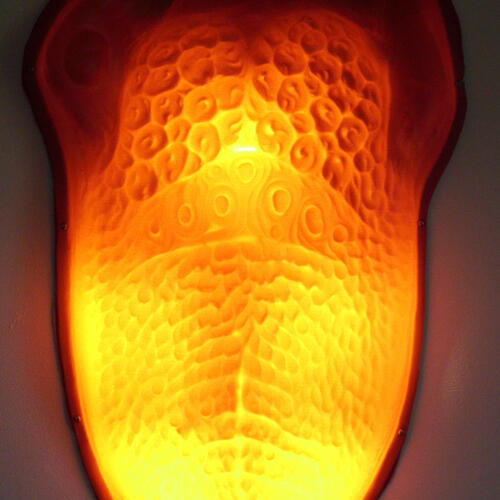Antoni Miralda
Art@Work, Miami
Antoni Miralda’s installation, Lingua, at Art@Work confirms the institutional overflow that has characterized this exhibition space located in the waiting room of a dentist’s office. Thus, the work of this Catalonian artist who presented in 2010 the retrospective De gustibus non disputandum at the Palacio Velázquez in Madrid’s Parque del Retiro, organized by the Reina Sofía Museum, was seen by patients caught unawares − and surprised!

Miralda, a maker of feasts, inaugurated the exhibition with a banquet in which succulent apples prepared by his partner, Montse Guillén, accompanied roast pork illumined by small fires. Part of the photographs of tongues that comprised the huge work Lengua de lenguas/Tongue of tongues, exhibited for the first time at the food pavilion of the Expo 2000 in Hannover, Germany, were displayed in the waiting room. Several of these had been shot by a camera that allowed visitors to take pictures of themselves showing their tongues during Miralda’s exhibition Las recetas de la abuela/Grandmother’s Recipes, featured at the Miami Art Museum. That challenging gesture, at the same time so intimate and so liberating, contains both the capacity to perform a unique record of identity and to document a form of catharsis and rupture of hegemonies that is a key trait in his work. There were also tongues that had been photographed during a Carnival celebration.
The discovery of “mythemes” or significant elements in the narratives or practices of culture that Levi Strauss developed on the basis of opposites such as the raw and the cooked; the cathartic function that Bahtin unraveled in the carnivalesque, that exuberant celebration that annihilates hierarchies and that Rabelais culled from the popular and transformed into literature, and the sense of the gargantuan feast, precede and pervade Miralda’s oeuvre. Instead of fulfilling the function of listing the ills that afflict the tribe, this playful artist-anthropologist documents and exhibits the good things linked to the tongue: flavor and knowledge of innumerable cultures that originate dishes (in its double association as container and preparation), sculptures, installations, performances, photographs, videos, making it possible to taste in countless places in the planet the stews of numerous cultures from all over the world.
In all fairness, Humberto Eco considers him the designer of a great festival of contemporary societies that “have lost the sense of the feast but have kept the obscure drive for it.” Rabelaisian, pantagruelian, Miranda disobeys the criteria of advertising aesthetics: all the tongues, all the open mouths he shows are perfect in their variety, in their expression of character, of singular identity, but also in the concert of a celebration that annihilates the categories of the beautiful and the grotesque.
That function that Levi-Strauss performed when he disdained European ethnocentricity and the notion of the primitive is transposed into a contemporary oeuvre that revives − through mediums such as the video also exhibited at Art@Works − cooking rites in Mauritania or Hannover and in countless cities, or towns, or villages where Miralda has explored − without ever being satisfied − the timeless metonymy that contains the one who speaks, the one who cultivates and the one who cooks the food, always expanding the preparation of the cultural universe. Human memory housed in dinner services, containers, vestiges or samples of culinary art and of its vast instrumental paraphernalia, and even testimonial documentations, and a delirious series of visual records that include music composed especially for the performances of his feasts, are the patrimony of the Foundation created by the Miralda FoodCulturaMuseum. In the cold industrial society, every element of festivity in his work takes us back to the original warmth of being fed.
-
 Dresden Tongue, 2000. Mixed media, 321/2 x 21 x 4 in. Photo and courtesy of the artist. Lengua de Dresden, 2000. Técnica
Dresden Tongue, 2000. Mixed media, 321/2 x 21 x 4 in. Photo and courtesy of the artist. Lengua de Dresden, 2000. Técnica
mixta, 82,5 x 53,3 x 10,1 cm. Foto y cortesía del artista.




